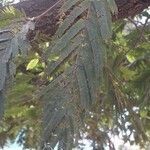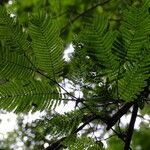Leaves 6-27 cm. long (rhachis + petiole); rhachis with a stipitate gland between each pinna-pair; no glands between leaflet-pairs; pinnae (7)12-23 pairs; leaflets (11)38-67 pairs, 2-6(9) x 0·5-1·5(2) mm., linear-oblong, often ± falcate; lateral nerves invisible beneath.
Tree 10-40 m. high, somewhat buttressed at the base; bark smooth; branchlets densely pubescent when young, often glabrescent later.
Flowers whitish or yellowish, in spikes 3·5-19 cm. long.
Anthers with an apical gland that soon falls off.
Seeds 4·1-7·5(?8) x 0·9-2·1 cm.
Pod 10-32 x 1·3-2-5 cm.



